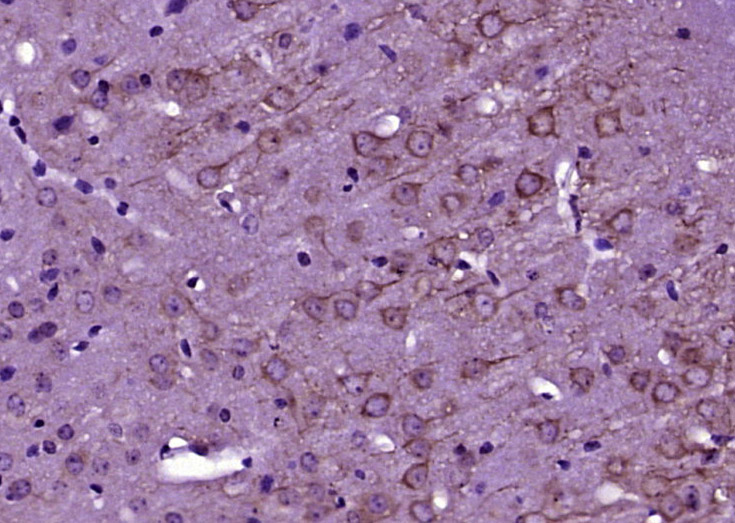
Rabbit Anti-phospho-EIF4G1 (Ser1238)antibody
eIF4G (phospho-Ser1238); eIF4G (phospho-S1238); p-eIF4G (Ser1238); p-eIF4G (S1238); eIF 4 gamma 1; eIF 4G 1; eIF 4G1; EIF4 gamma; EIF4F; EIF4G; EIF4GI; Eukaryotic translation initiation factor 4 gamma 1; p220; DKFZp686A1451; eIF-4-gamma 1; eIF-4G 1; eIF-4
View History [Clear]
Details
Product Name phospho-EIF4G1 (Ser1238) Chinese Name 磷酸化真核翻译起始因子4G抗体 Alias eIF4G (phospho-Ser1238); eIF4G (phospho-S1238); p-eIF4G (Ser1238); p-eIF4G (S1238); eIF 4 gamma 1; eIF 4G 1; eIF 4G1; EIF4 gamma; EIF4F; EIF4G; EIF4GI; Eukaryotic translation initiation factor 4 gamma 1; p220; DKFZp686A1451; eIF-4-gamma 1; eIF-4G 1; eIF-4G1; EIF4G-I; IF4G1_HUMAN. Product Type Phosphorylated anti Research Area Tumour Cell biology immunology transcriptional regulatory factor Immunogen Species Rabbit Clonality Polyclonal React Species Mouse, (predicted: Human, Rat, ) Applications ELISA=1:5000-10000 IHC-P=1:100-500 IHC-F=1:100-500 IF=1:100-500 (Paraffin sections need antigen repair)
not yet tested in other applications.
optimal dilutions/concentrations should be determined by the end user.Theoretical molecular weight 175kDa Cellular localization cytoplasmic Form Liquid Concentration 1mg/ml immunogen KLH conjugated Synthesised phosphopeptide derived from human EIF4G1 around the phosphorylation site of Ser1238: AL(p-S)EE Lsotype IgG Purification affinity purified by Protein A Buffer Solution 0.01M TBS(pH7.4) with 1% BSA, 0.03% Proclin300 and 50% Glycerol. Storage Shipped at 4℃. Store at -20 °C for one year. Avoid repeated freeze/thaw cycles. Attention This product as supplied is intended for research use only, not for use in human, therapeutic or diagnostic applications. PubMed PubMed Product Detail The protein encoded by this gene is a component of the multi-subunit protein complex EIF4F. This complex facilitates the recruitment of mRNA to the ribosome, which is a rate-limiting step during the initiation phase of protein synthesis. The recognition of the mRNA cap and the ATP-dependent unwinding of 5'-terminal secondary structure is catalyzed by factors in this complex. The subunit encoded by this gene is a large scaffolding protein that contains binding sites for other members of the EIF4F complex. A domain at its N-terminus can also interact with the poly(A)-binding protein, which may mediate the circularization of mRNA during translation. Alternative splicing results in multiple transcript variants, some of which are derived from alternative promoter usage. [provided by RefSeq].
eIF4G1 (eukaryotic translation Initiation Factor 4 Gamma 1) is a component of the protein complex eIF-4 which is involved in the recognition of the mRNA cap ATP-dependent unwinding of the 5'-terminal secondary structure and recruitment of mRNA to the ribosome. eIF4G plays a critical role in protein expression and is at the center of a complex regulatory network. Together with the cap-binding protein eIF4E, it recruits the small ribosomal subunit to the 5'-end of mRNA and promotes the assembly of a functional translation initiation complex which scans along the mRNA to the translation start codon. Human eIF4G contains three consecutive HEAT domains, as well as long unstructured regions involved in multiple protein-protein interactions. The interactions of eIF4G1 with other factors are largely unknown.
Function:
Component of the protein complex eIF4F, which is involved in the recognition of the mRNA cap, ATP-dependent unwinding of 5'-terminal secondary structure and recruitment of mRNA to the ribosome.
Subunit:
eIF4F is a multi-subunit complex, the composition of which varies with external and internal environmental conditions. It is composed of at least EIF4A, EIF4E and EIF4G1/EIF4G3. Interacts with eIF3, mutually exclusive with EIF4A1 or EIFA2, EIF4E and through its N-terminus with PAPBC1. Interacts through its C-terminus with the serine/threonine kinases MKNK1, and with MKNK2. Appears to act as a scaffold protein, holding these enzymes in place to phosphorylate EIF4E. Non-phosphorylated EIF4EBP1 competes with EIF4G1/EIF4G3 to interact with EIF4E; insulin stimulated MAP-kinase (MAPK1 and MAPK3) phosphorylation of EIF4EBP1 causes dissociation of the complex allowing EIF4G1/EIF4G3 to bind and consequent initiation of translation. EIF4G1/EIF4G3 interacts with PABPC1 to bring about circularization of the mRNA. Rapamycin can attenuate insulin stimulation mediated by FKBPs. Interacts with EIF4E3. Interacts with CIRBP and MIF4GD. Interacts with rotavirus A NSP3; in this interaction, NSP3 takes the place of PABPC1 thereby inducing shutoff of host protein synthesis. Interacts with RBM4.
Post-translational modifications:
Phosphorylated at multiple sites in vivo. Phosphorylation at Ser-1185 by PRKCA induces binding to MKNK1.
Following infection by certain enteroviruses, rhinoviruses and aphthoviruses, EIF4G1 is cleaved by the viral protease 2A, or the leader protease in the case of aphthoviruses. This shuts down the capped cellular mRNA transcription.
DISEASE:
Parkinson disease 18 (PARK18) [MIM:614251]: An autosomal dominant, late-onset form of Parkinson disease. Parkinson disease is a complex neurodegenerative disorder characterized by bradykinesia, resting tremor, muscular rigidity and postural instability, as well as by a clinically significant response to treatment with levodopa. The pathology involves the loss of dopaminergic neurons in the substantia nigra and the presence of Lewy bodies (intraneuronal accumulations of aggregated proteins), in surviving neurons in various areas of the brain. Note=The disease is caused by mutations affecting the gene represented in this entry.
Similarity:
Belongs to the eukaryotic initiation factor 4G family.
Contains 1 MI domain.
Contains 1 MIF4G domain.
Contains 1 W2 domain.
SWISS:
Q04637
Gene ID:
1981
Database links:Entrez Gene: 1981 Human
Entrez Gene: 208643 Mouse
Omim: 600495 Human
SwissProt: Q04637 Human
SwissProt: Q6NZJ6 Mouse
Unigene: 433750 Human
Unigene: 260256 Mouse
Unigene: 101803 Rat
Product Picture
References (0)
No References
Bought notes(bought amounts latest0)
No one bought this product
User Comment(Total0User Comment Num)
- No comment



 +86 571 56623320
+86 571 56623320
 +86 18668110335
+86 18668110335

